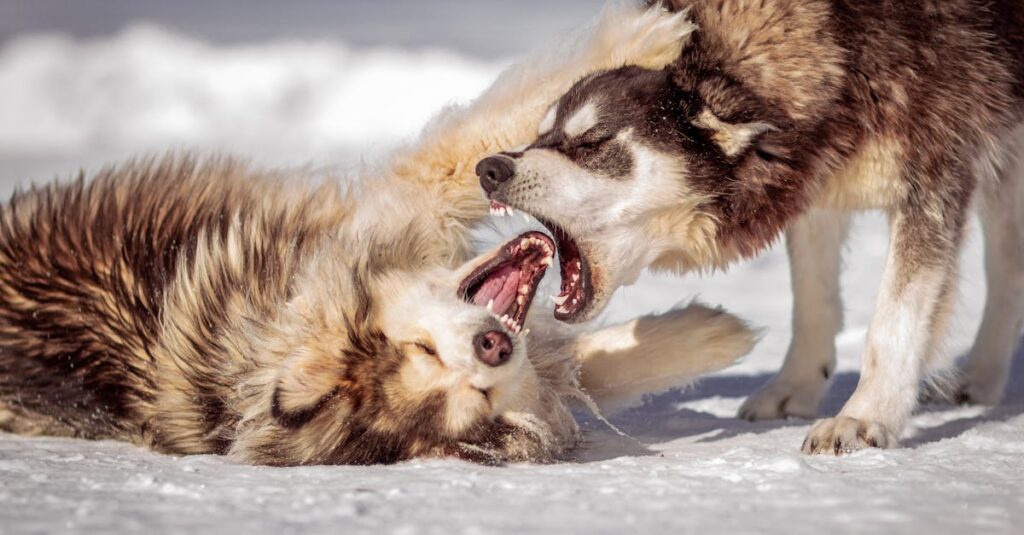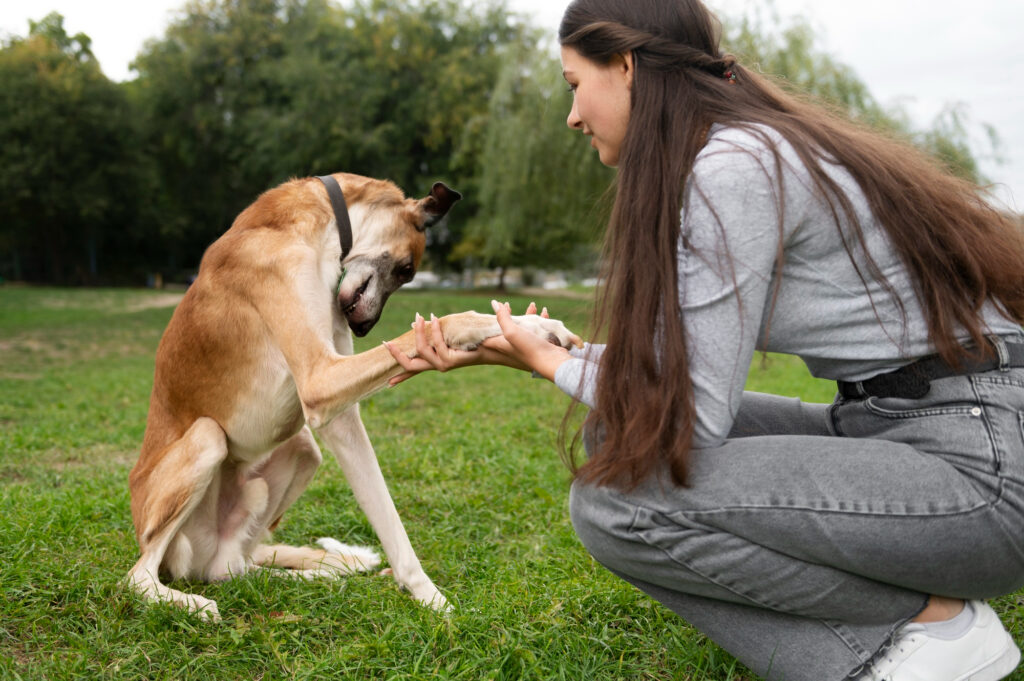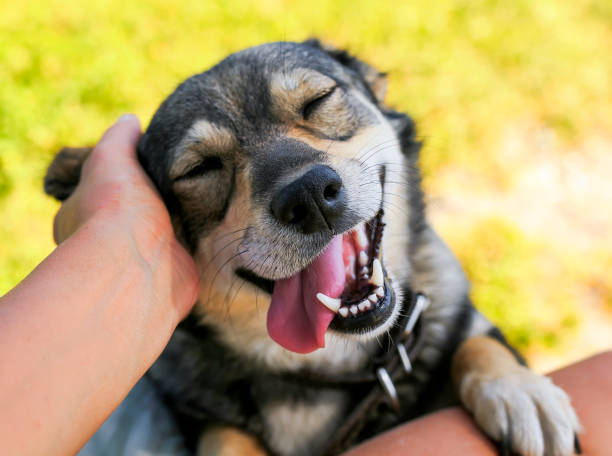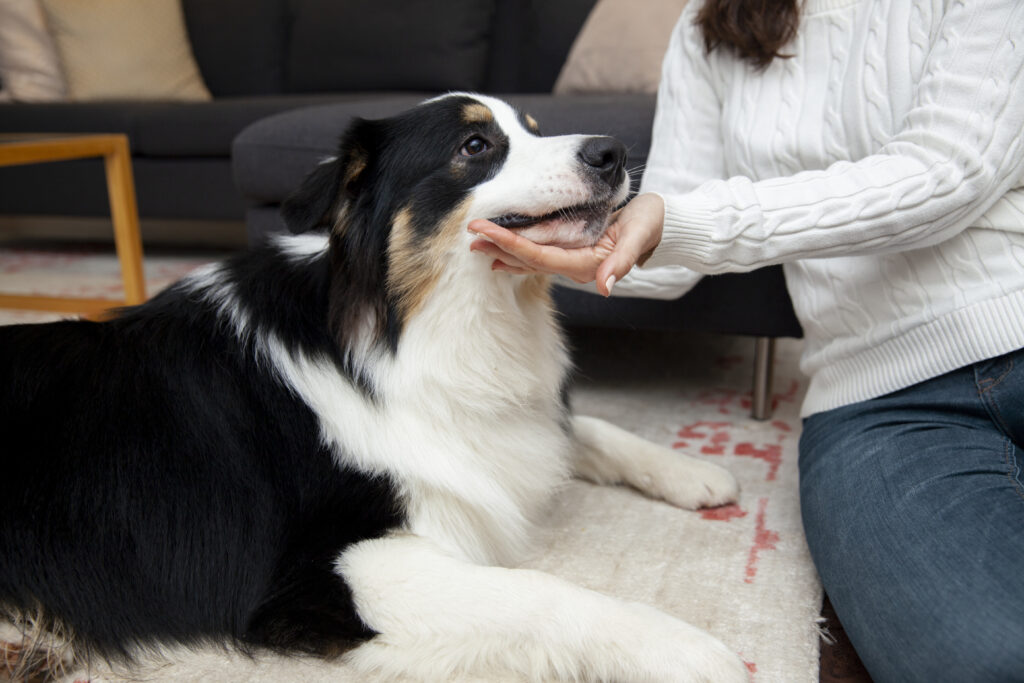
So, you’ve got a furry friend – a playful pup who brings sunshine (and maybe a few muddy paw prints) into your life. But sometimes, that playfulness can turn into a bit of a problem, especially when it involves those tiny, sharp teeth.
If your dog is biting or nipping, you’re not alone. It’s a common behavior, especially in puppies, but it’s important to address it early on to keep everyone safe and happy. This article will explore the reasons behind dog biting and nipping, how to stop your dog from biting and nipping, and the different ways you can train your furry friend to be more gentle. We’ll also delve into the potential risks of ignoring this behavior and answer some frequently asked questions.
Also Read: 5 Reasons Why Do Dogs Roll on Their Backs? A Comprehensive Guide
Why Do Dogs Bite and Nip?
There are many reasons why dogs might bite or nip. Here are some of the most common culprits:
- Puppy Play: Puppies explore the world with their mouths, just like babies explore with their hands. Nipping and mouthing can be a normal part of play for them.
- Teething: Teething puppies experience discomfort in their gums, and chewing or nipping can help to relieve the pain.
- Seeking Attention: Sometimes, even if it’s negative attention, a dog might nip at your hands or feet to get you to play with them.
- Fear or Anxiety: In some cases, a dog might nip if they feel scared, threatened, or cornered.
- Herding Instinct: Certain breeds, like collies or Australian Shepherds, might have a natural instinct to “herd” by nipping at your heels.

The Benefits of Stopping Biting and Nipping
While it might seem like harmless puppy play, there are many benefits to teaching your dog not to bite and nip.
- Safety: A playful nip from a puppy can easily turn into a painful bite for an adult or a child. It’s important to prevent this kind of behavior before it becomes a bigger problem.
- Building Trust: A dog who understands bite inhibition builds trust with you and others.
- Gentler Interactions: You’ll be able to enjoy playtime and cuddling with your dog without the worry of getting nipped.
- Preventing Fear-Based Biting: If a dog learns to associate biting with getting a negative reaction, they might be more likely to bite out of fear in the future.

The Risks of Ignoring Biting and Nipping
Ignoring your dog’s biting and nipping behavior can lead to some unwanted consequences:
- Escalation: A playful nip can easily turn into a more serious bite if it’s not addressed.
- Fear-Based Biting: As mentioned earlier, ignoring biting behavior can lead to a dog associating biting with getting a reaction, making them more likely to bite out of fear in the future.
- Socialization Issues: Other dogs and people might not be as tolerant of biting behavior, which can make it difficult for your dog to socialize with others.
Also Read: 07 Major Reasons Why is my Dog Aggressive towards Other Dogs
Training Your Dog to Stop Biting and Nipping:
The good news is that biting and nipping can be trained out with patience and consistency. Here are some effective techniques:
- Redirect with Toys: When your dog starts to nip, immediately redirect their attention to a chew toy. This gives them an appropriate outlet for their chewing needs.
- The “Ouch” Method: When your dog nips, yelp loudly in a high-pitched voice, like a startled puppy. This will mimic the reaction of another puppy who has been bitten too hard and helps your dog understand that the bite is too strong.

- Time Outs: If your dog continues to nip after redirecting or using the “ouch” method, calmly disengage from them and walk away for a few seconds. This shows them that biting results in the loss of playtime.
- Reward Good Behavior: When your dog plays gently, praise them lavishly and offer treats. This reinforces the positive behavior you want to see.
- Be Consistent: The key to success is consistency. Make sure everyone interacting with your dog is using the same training methods.
Additional Tips:
- Be patient: Training your dog to stop biting and nipping takes time and consistency. Don’t get discouraged if you don’t see results immediately.
- Make it fun: Keep training sessions positive and fun for both you and your dog.
- Be gentle: Always handle your dog with gentleness and respect.
- Socialization: Proper socialization is key to preventing biting and nipping behavior. Expose your dog to different people, animals, and environments from a young age.
Additional Resources:
Here are some resources that you might find helpful:
- The American Society for the Prevention of Cruelty to Animals (ASPCA) ([aspca.org]): The ASPCA website has a wealth of information on dog training, including tips on stopping biting and nipping.
- The Association of Professional Dog Trainers (APDT) ([apdt.com]): The APDT website can help
Final Thoughts: Building a Happy and Bite-Free Relationship with Your Dog
Nipping and biting might seem like a normal part of puppyhood, but addressing this behavior early on sets the stage for a harmonious relationship with your furry friend. Remember, a well-trained dog is not only safer for everyone but also a joy to live with.
By understanding the reasons behind your dog’s biting, employing positive reinforcement techniques, and seeking professional help when necessary, you can create a happy and bite-free life together. Here are some key takeaways to remember:
- Be Patient and Consistent: Training takes time and consistent effort. Don’t get discouraged if you don’t see immediate results.
- Positive Reinforcement is Key: Reward good behavior with praise, treats, or affection. This motivates your dog to repeat the desired behavior.
- Make it Fun!: Keep training sessions positive and engaging for both you and your dog.
- Socialization is Essential: Properly socialize your dog from a young age to prevent fear-based biting and nipping.
- Seek Professional Help: Don’t hesitate to consult a certified dog trainer or behaviorist if you’re struggling to address your dog’s biting behavior.
With patience, love, and positive reinforcement, you can turn those tiny nips into gentle licks and build a strong bond with your canine companion.
How to Stop Your Dog from Biting and Nipping: FAQ
Those tiny puppy teeth might seem harmless, but their nips can quickly turn into painful bites. Here are some frequently asked questions about how to address this common behavior:
- My puppy loves to nip at my hands and feet during playtime. How can I teach them gentler play?
This is a classic case of puppy exploration! Pups use their mouths to learn about the world around them, and during play, those nips might be their way of interacting with you. Here’s how to redirect that energy:
- Redirect with Toys: Keep a variety of chew toys readily available during playtime. When your pup starts nipping, immediately redirect their attention to a toy. This provides them with an appropriate outlet for their chewing needs and teaches them that toys are the acceptable way to play with their mouth.
- The “Ouch” Method: When your pup nips, yelp loudly in a high-pitched voice, similar to a startled puppy. This mimics their natural reaction to being bitten too hard by a littermate and helps them understand that the bite was too strong.
- Time Outs: If the nipping continues after redirecting or using the “Ouch” method, calmly disengage from your pup. Get up and walk away for a short period (around 10-15 seconds) to show them that biting results in the end of playtime.
- My dog nips out of excitement when I greet them after being gone. What can I do?
Excited greetings can trigger playful nipping in some dogs. Here’s how to manage this behavior:
- Stay Calm: When you return home, resist the urge to greet your dog with a big hug or shower them with attention right away. Instead, remain calm and wait for them to settle down a bit.
- Controlled Greeting: Once your dog is calmer, have them sit or stay before initiating any interaction. Reward them with a treat or praise for good behavior. This teaches them that a calm greeting earns them a reward, not excited nipping.
- My dog is teething, and the nipping seems worse than usual. How can I soothe their discomfort?
Teething puppies experience gum discomfort, and chewing helps alleviate that pain. Here are some ways to provide relief and redirect their chewing:
- Teething Toys: Offer a variety of teething toys made from safe materials like rubber or nylon. These toys help massage gums and provide an outlet for chewing.
- Frozen Treats: Stuff a Kong toy with wet food or broth and freeze it. The coldness numbs their gums while providing a delicious distraction.
- Supervise Chewing: Keep a close eye on your pup during chewing sessions to ensure they’re only chewing on appropriate toys.
- My dog only nips at certain people, like children or strangers. Why is that?
This could be a sign of fear or anxiety. Dogs who haven’t been properly socialized around children or strangers might feel threatened by them and nip as a defense mechanism.
What can you do?
- Supervised Interactions: Always supervise your dog’s interactions with children and strangers. This allows you to intervene if your dog exhibits any signs of discomfort.
- Positive Reinforcement: Slowly introduce your dog to children and strangers in a positive way. Use treats and praise to create a positive association. Start from a distance and gradually decrease the distance as your dog becomes more comfortable.
- Consider a Trainer: If your dog shows significant fear or anxiety, consider consulting with a professional dog trainer who can help you create a safe and effective socialization plan.
- My adult dog has just started nipping, and I’m not sure why. What could be causing this?
There can be several reasons why an adult dog might suddenly start nipping. Here are some possibilities:
- Medical Issues: Sometimes, underlying medical conditions like pain or discomfort can cause a dog to become irritable and nip. If the behavior is sudden and out of character, consult your veterinarian to rule out any medical concerns.
- Frustration: If your dog feels frustrated or unable to communicate their needs effectively, they might resort to nipping. This could be due to boredom, lack of exercise, or confusion about what’s expected of them.
- Seeking Attention: Even if it’s negative attention, some dogs might nip at your hands or feet to get you to play with them.
What can you do?
- Address the Underlying Cause: Once you identify the reason behind the nipping, you can address it directly. If it’s medical, follow your veterinarian’s recommendations. For frustration or attention-seeking, provide adequate exercise, mental stimulation, and positive reinforcement for desired behaviors.
- I’ve tried redirecting with toys and using the “Ouch” method, but my dog keeps nipping. What am I doing wrong?
There are a few things to consider if the initial training methods aren’t showing results:
- Consistency is Key: Training takes time and consistency. Make sure everyone interacting with your dog is using the same methods and avoiding any mixed messages.
- Timing is Crucial: The “Ouch” method is most effective when delivered immediately after the nip. A delayed reaction might confuse your dog.
- Intensity Matters: The “Ouch” should be a startled yelp, not a yell or punishment. A harsh tone might scare your dog and worsen the behavior.
- Consider the Toys: Ensure the toys you’re offering are interesting and engaging for your dog. Variety is key! Experiment with different textures and shapes to find what your dog enjoys most.
- Seek Professional Help: If you’ve been consistent with training for a while and your dog still nips, consider consulting a certified dog trainer. They can observe your interactions and provide personalized guidance tailored to your dog’s specific needs and learning style.
- Should I use treats to bribe my dog into not nipping?
Treats are a valuable tool in dog training, but using them to “bribe” your dog might not be the most effective approach for nipping. Here’s why:
- Focus on the Behavior: The goal is to teach your dog that nipping is unacceptable, not just to stop them temporarily for a treat. Reward desired behaviors like gentle play or calmness, not the absence of nipping.
- Unwanted Associations: If your dog only avoids nipping because they expect a treat, they might become more persistent in the future, hoping to eventually get a reward.
- Timing Challenges: The timing of treats is crucial for effective reinforcement. Rewarding after a nip might accidentally reinforce the unwanted behavior.
- Is it okay to use a squirt bottle or spray with water to stop my dog from nipping?
While some people use squirt bottles with water to deter unwanted behavior, it’s not the most recommended approach. Here’s why:
- Fear and Anxiety: Using a squirt bottle can create fear and anxiety in your dog, which can worsen the nipping behavior in the long run.
- Mixed Messages: The sudden spray might startle your dog but doesn’t necessarily connect the spray with the nipping behavior. This can lead to confusion and frustration.
- Positive Reinforcement: Positive reinforcement techniques, like redirection and praise for good behavior, are generally more effective and build trust with your dog.
- My dog growls or snarls before they nip. What should I do?
Growling and snarling are often warning signs that a dog feels uncomfortable or threatened. If your dog exhibits these behaviors before nipping or biting, it’s important to stop the interaction immediately. Here’s what to do:
- Identify the Trigger: Try to understand what’s causing your dog to feel uncomfortable. It could be something as simple as feeling cornered or wanting their space.
- Remove the Trigger: If possible, remove the trigger that’s causing your dog’s discomfort. For example, if they growl when you try to pet them while they’re eating, wait until they’re finished before giving them affection.
- Seek Professional Help: If your dog frequently growls or snarls before nipping, it’s important to consult with a professional dog trainer or behaviorist to address the underlying cause. They can help you create a safe and effective training plan to address the growling and nipping behavior.
- I’ve tried everything and my dog still bites! What should I do?
If you’ve been consistent with positive reinforcement training for a while and your dog is still biting, it might be time to seek professional help. A certified dog trainer or behaviorist can assess your dog’s individual needs and create a personalized training plan. Here’s what they can offer:
- Personalized Approach: A trainer can observe your interactions with your dog and identify any areas where you might be inadvertently reinforcing the biting behavior.
- Addressing Underlying Issues: Sometimes, biting can stem from deeper anxieties, dominance issues, or even medical problems. A trainer can help you identify and address these underlying causes.
- Structured Training Plan: A trainer can create a structured training plan tailored to your dog’s learning style and temperament. This might involve specific exercises, desensitization techniques, and management strategies while training progresses.
- Ongoing Support: Professional trainers can provide ongoing support and guidance throughout the training.

